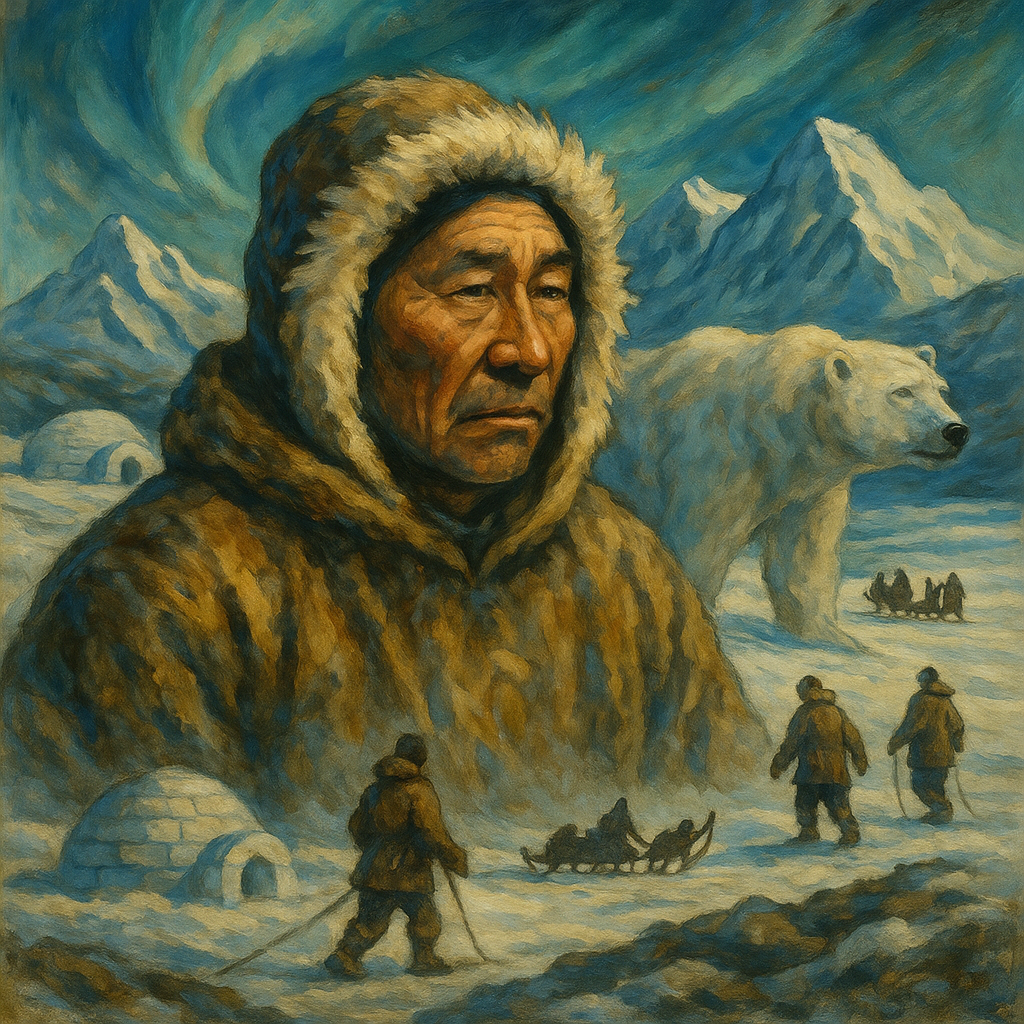Introduction to Inuit Culture and Geographical Context
The Inuit, originally referred to as the Eskimo, are an Indigenous people living in the Arctic regions of Canada, Greenland, and Alaska. Their culture has evolved over thousands of years, deeply intertwined with the challenging and often harsh Arctic environment. Characterized by extreme cold, ice, snow, and long periods of darkness, the Arctic demands extraordinary resilience and adaptability from its inhabitants. The Inuit have historically thrived in this landscape through a deep understanding of their natural environment, communal living, and cultural practices that emphasize respect, sustainability, and strength.
Geographical Context
Inuit land, spanning across the Arctic, is composed of ice sheets, tundra, and marine environments that host a range of wildlife, including seals, polar bears, and whales. The environment not only shapes the physical practices of the Inuit—such as hunting, fishing, and constructing igloos—but also their social structures and ways of knowing, which place a significant emphasis on collaboration and community survival. Contemporary challenges, such as climate change, which dramatically affects the Arctic environment, make the teachings of Inuit culture particularly relevant and urgent today.
Inuit Teachings and Stories that Illustrate Resilience
Inuit culture is rich with stories and teachings imbued with lessons on resilience. The oral tradition of storytelling serves as a medium for conveying cultural values, collective memory, and teachings about strength and endurance.
Stories of Survival
One prominent story that exemplifies resilience is the narrative of Kiviuq, known as the Inuit Noah. Kiviuq embarks on a series of adventures that highlight his tenacity against insurmountable odds. From battling monsters to overcoming extreme weather conditions, Kiviuq’s journey showcases the importance of courage, resourcefulness, and connection to the community. Each tale ends with lessons learned, reinforcing the concept of resilience in the face of adversity.
Cultural Practices of Resilience
The practice of Hunting and Sharing reflects a cornerstone of Inuit resilience. Hunting is not just a means of sustenance; it represents a communal effort that strengthens familial and social bonds. When a successful hunt occurs, food is shared among the community members, ensuring survival for all. This practice teaches the value of cooperation, communal strength, and the significance of reciprocity—principles that are essential in alleviating the pressures of modern living, where individualism often prevails.
Furthermore, the practice of silence in the community is notable; Inuit culture emphasizes the philosophical significance of silence and patience. During hunting excursions, silence fosters a sense of focus and enhances alertness to the surrounding environment. This concept transcends the act of hunting, as it teaches individuals to cultivate mindfulness and presence in their everyday lives. The ability to endure silence and discomfort is a profound strength, navigating both the physical and emotional challenges of life.
Application of These Teachings to Modern-Day Life and Challenges
The lessons gleaned from Inuit culture resonate far beyond the Arctic, offering substantial wisdom that can be applied to contemporary life and challenges.
Resilience in the Face of Climate Change
As global warming continues to impact the Arctic—changing weather patterns, melting ice, and threatening traditional subsistence lifestyles—Inuit resilience becomes a guiding light. The Inuit have played an active role in advocating for climate justice, sharing their lived experiences with the broader world. Their insights highlight the vulnerability of the ecosystem and illustrate how climate change disproportionately affects Indigenous communities. By adopting Inuit strategies for adaptation and sustainability, individuals around the globe can learn to respect and adapt to their environments while cultivating resilience in their communities.
Building Community Ties
In a world that often feels disconnected, the Inuit’s emphasis on community reminds us of the strength found in connection and support. Initiatives that promote community engagement—such as cooperative businesses, local gardens, or support networks—can forge resilience and foster an enduring sense of belonging. The practice of sharing skills and resources mirrors the communal hunting practices of the Inuit, emphasizing that when challenges arise, unity and camaraderie create lasting strength.
Mindfulness and Presence
Incorporating mindfulness practices rooted in the principles of Inuit silence can lead to greater emotional resilience. Modern mental health struggles often stem from disconnection and overwhelm. By embracing periods of silence, reflection, and meditation, individuals can equip themselves with the mental fortitude necessary to navigate personal adversities. The Inuit teach us that enduring discomfort can lead to personal growth, provided we are willing to pause, listen, and connect deeply with ourselves and our surroundings.
Comparative Analysis: Arctic Life vs. Contemporary Global Challenges
Contrasting the life of the Inuit with current global scenarios underscores similarities in resilience required by different communities in the face of change. Whether it’s economic strife, migration crises, or pandemics, humans globally face pressures reminiscent of those historically experienced by the Inuit. These layers of challenges necessitate robust strategies for survival and adaptation.
While Inuit communities rely on traditional ecological knowledge to navigate their circumstances, contemporary societies can harness technology, grassroots movements, and innovative thinking to build resilience. The Inuit’s holistic perception of their world serves as a model for sustainable development that modern societies can learn from, suggesting that resilience is deeply contextual and tied to specific cultural understandings of the environment.
The Philosophical Significance of Silence
Finally, the Inuit embrace of silence is significant in our racing world where noise and distraction reign supreme. Taking inspiration from Inuit practices can encourage a radical shift in the way we approach daily life, promoting the power of pause, reflection, and cultivation of inner strength. The quiet resilience of silence transforms into an active force that encourages personal and communal introspection, ultimately guiding individuals toward stronger societal constructs.
Conclusion
The teachings from Inuit culture offer profound insights into resilience, celebration of communal strength, and respect for the environment. As modern challenges compound, the wisdom encoded in Inuit stories—teaching resilience, community, and mindfulness—remains relevant. By learning to appreciate the strength of Inuit culture, rooted deeply in survival and sustainability, modern societies can cultivate adaptive strategies that resonate well beyond geographical and cultural boundaries.
Summary
This analysis delves into the resilience of Inuit culture, emphasizing their teachings and stories as essential tools to navigate contemporary challenges. Through the lens of Inuit experiences, we can learn the importance of community, the power of silence, and the strength of adapting to our environment—all vital elements for fostering resilience today.
FAQ Section
Q1: What is the significance of storytelling in Inuit culture?
A1: Storytelling in Inuit culture serves as a vital medium to transmit values, history, and teachings about survival and resilience. These narratives often carry moral lessons that reflect communal experiences and highlight the trials faced by the community, reinforcing group identity and knowledge.
Q2: How do Inuit cultural practices promote community resilience?
A2: Inuit cultural practices, such as communal hunting and food sharing, foster a spirit of cooperation and interconnectedness. These practices teach the importance of working together to ensure survival and promote resource sharing—important elements of community resilience in the face of challenges.
Q3: What role does silence play in Inuit wisdom, and how can it be applied to modern life?
A3: Silence in Inuit culture is a source of strength, aiding mindfulness and focus during hunting and daily life. In modern contexts, adopting periods of reflection and stillness can enhance mental resilience, helping individuals navigate stress and uncertainty more effectively.
Q4: How can we integrate lessons from Inuit culture into our response to climate change?
A4: Learning from Inuit adaptive strategies, such as sustainable practices rooted in traditional ecological knowledge, can inform broader responses to climate justice. Engaging Indigenous voices in climate discussions fosters inclusive solutions that respect local ecosystems and communities.
Q5: What can modern societies learn from the resilience exhibited by Inuit communities?
A5: Modern societies can draw from the Inuit emphasis on community, environmental stewardship, and adaptability. These lessons underscore the need for connectedness and sustainable living, teaching us that true resilience involves working together to face both personal and collective challenges.


